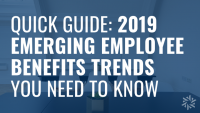2013 is a big year for benefits. As Human Resource departments, C-suite execs and benefits advisers prepare for open enrollment in 2013, we all face challenges. Regardless of the decision your organization makes about the fate of your benefits package, a communication strategy is paramount.
1. Communication is key
The Patient Protection and Affordable Care Act regulations are requiring employers to educate their employees in ways they may not have previously. From an easy-to-understand Summary of Benefits and Coverage to the Notice of the Exchange (to be required this Summer/Fall), legislation calls for better communication of benefits. Employers need their employees to understand how it all works-regardless of whether they offer coverage or send their employees to the Exchange.
2. Be proactive
It may be easier said than done, but the companies that are proactively developing a communication strategy now will find that decisions will come easier during renewal and open enrollment because you’ve already developed a way to relay information. This strategy should deliver information in a meaningful way and set expectations for how it will be shared in the future.
3. Transparency
Being transparent about benefits goes hand in hand with a proactive approach. Small businesses may decide to send their employees to the individual marketplace. Larger organizations may be banking on offsetting costs by increasing the employee contributions. Whatever the strategic direction, it’s important to be as transparent about that decision as possible. For example, as you decide, let your staff know it’s a top priority and that an update will be provided to them as soon as possible. Uncertainty about benefits and compensation can be detrimental to the morale of your workforce – so find a way to share what you can with your staff.
4. Wrap it up with wellness
Consider enhancing your communication strategy with the promotion of your employees’ overall wellness. For example, employer groups that continue offering an employer-sponsored plan can focus on helping employees become better health care consumers. By doing so, employees won’t only be looking at their benefits when their sick, they’ll be making good decisions about prescription drugs (generic vs. formulary) and preventive visits. If you’re a small employer who plans to send your employees to the exchange marketplace, show your concern for their well-being by recommending services that can aid them in decision-making. Even if you don’t plan to have a benefits program in the future, you can show concern for your employees’ wellness in a number of ways.
5. Brand your benefits
If there has ever been a time to brand your benefits package, it’s now. Putting a name, logo or image behind your benefits package increases is tangibility. It also demonstrates that as an employer group, you place significant time and resources into your benefits package because you care about your employees. In addition, a benefits brand can aid in information retention.
A marketing spin on your benefits package helps “sell” the benefits to your employees, just as you may sell your services to your customers. After all, benefits are intended to help recruit and retain talent, right?
6. Daily support
Let’s recap. We’ve identified why communication is key this year and how a proactive and transparent approach can aid in sharing your message. Wrapping your communication strategy with wellness and branding your benefits package can help demonstrate the significance you place on taking care of your employees. So, now what?
Questions will undoubtedly arise as you launch a benefits communication strategy, so having the right support in place is key. Remember, communication is a two-way street. For every engaging email or notice you post for your employees, you can expect to have that many questions in return. Who helps you develop a benefits strategy and effectively communicate it to employees? For some, the answer is AFG. Others may still be figuring that out. Regardless, carpe diem! Seize the day! Today is the day to rethink your benefits communication strategy.


